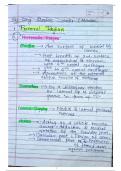Upper limb muscle - Study guides, Class notes & Summaries
Looking for the best study guides, study notes and summaries about Upper limb muscle? On this page you'll find 44 study documents about Upper limb muscle.
All 44 results
Sort by
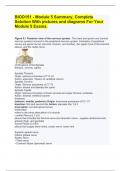
-
BIOD151 - Module 5 Summary, Complete Solution With pictures and diagrams For Your Module 5 Exams.
- Summary • 29 pages • 2024
-
- $14.49
- + learn more
BIOD151 - Module 5 Summary, Complete Solution With pictures and diagrams For Your Module 5 Exams. Figure 5.1 Posterior view of the nervous system. The brain and spinal cord (central nervous system) connect to the peripheral nervous system. Examples of peripheral nerves are spinal nerves (cervical, thoracic, and lumbar), the upper trunk of the brachial plexus, and the radial nerve. (3) Divisions of the Spinalis thoracis, cervicis, capitis Spinalis Thoracis Origin: spinous processes ...
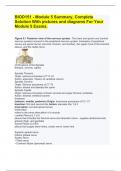
-
BIOD151 - Module 5 Summary, Complete Solution With pictures and diagrams For Your Module 5 Exams.
- Summary • 29 pages • 2024
-
Available in package deal
-
- $14.99
- + learn more
BIOD151 - Module 5 Summary, Complete Solution With pictures and diagrams For Your Module 5 Exams. Figure 5.1 Posterior view of the nervous system. The brain and spinal cord (central nervous system) connect to the peripheral nervous system. Examples of peripheral nerves are spinal nerves (cervical, thoracic, and lumbar), the upper trunk of the brachial plexus, and the radial nerve. (3) Divisions of the Spinalis thoracis, cervicis, capitis Spinalis Thoracis Origin: spinous processes ...
all upper limb muscles,their actions and nerve supply and imp spaces and triangle of upper limb and cubital fossa
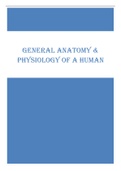
-
General Anatomy & Physiology of a Human (1)
- Summary • 50 pages • 2022
-
- $12.99
- + learn more
GENERAL ANATOMY & PHYSIOLOGY OF A HUMAN General Anatomy & Physiology of a Human - Lowest hierarchy is at the organelles within a cell - Cells with the same functions collected into larger groups -> tissues - Tissues are collected into organs which carry out a single task - Organs work together in organ systems that perform large-scale functions Cell Parts - Organelles -> cell parts that function within a cell o Coordinate with other organelles to perform a cell’s basic function...
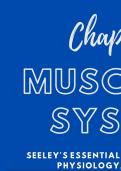
-
Chapter 7 Muscular System I Seeley's Essentials of Anatomy and Physiology, 9th Edition I Johmel De Ocampo
- Summary • 39 pages • 2023
-
- $7.99
- + learn more
Chapter key points: Muscle fibers are organized into fasciculi, and fasciculi are organized into muscles by associated connective tissue. Each skeletal muscle fiber is a single cell containing numerous myofibrils. Myofibrils are composed of actin and myosin myofilaments. Sarcomeres are joined end-to-end to form myofibrils. Cell membranes have a negative charge on the inside relative to a positive charge outside. This is called the resting membrane potential. Action potentials a...
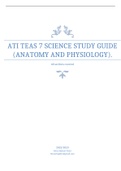
-
ATI TEAS 7 SCIENCE STUDY GUIDE (ANATOMY AND PHYSIOLOGY
- Summary • 20 pages • 2022
-
Available in package deal
-
- $15.49
- + learn more
All sections covered ATI TEAS 7 SCIENCE STUDY GUIDE (ANATOMY AND PHYSIOLOGY). ATI TEAS 7 Science Study Guide (Anatomy and Physiology). Cell Cell: basic organizational unit of all living things. One thing in common is they all have membranes (phospholipids). Cell structure organization: All cells contain DNA, and RNA & can synthesize proteins. Consists of nucleic acids, cytoplasm, and cell membrane. o Tissues: Cells that are grouped together o Organs: Tissues that ar...
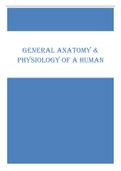
-
GENERAL ANATOMY & PHYSIOLOGY OF A HUMAN
- Summary • 50 pages • 2023
-
- $11.49
- + learn more
GENERAL ANATOMY & PHYSIOLOGY OF A HUMAN General Anatomy & Physiology of a Human - Lowest hierarchy is at the organelles within a cell - Cells with the same functions collected into larger groups -> tissues - Tissues are collected into organs which carry out a single task - Organs work together in organ systems that perform large-scale functions Cell Parts - Organelles -> cell parts that function within a cell o Coordinate with other organelles to perform a cell’s basic function...

-
TEST STUDY GUIDE FOR SCIENCE.
- Summary • 49 pages • 2023
-
- $11.49
- + learn more
TEST STUDY GUIDE FOR SCIENCE. Test Study Guide for Science. Cell Cycle ● Mitosis = “daughter cell” exact replica o Interphase (G1, S, G2) o Prophase o Metaphase o Anaphase o Telophase o Cytokinesis ● Meiosis = “daughter cells” different genetic coding o Only happens in gametes* o 1 st phase ● chromosomes cross over ● genetic material exchanged ● tetrads of 4 chromatids formed □ Homologous pairs of chromatids are separated and go to different poles □2 cel...

-
Science (Human Anatomy and Physiology) (1)
- Summary • 72 pages • 2022
-
- $11.49
- + learn more
SCIENCE (HUMAN ANATOMY AND PHYSIOLOGY) Science (Human Anatomy and Physiology) Hierarchy of Structures Lowest Hierarchy level is at Organelles within a cell. They obtain energy from food and reproduction. -Cells with the same function are collected into larger groups called Tissues. -Tissues are collected into Organs, carry out single task, like oxygenated blood (lungs), or filter out waste (kidneys). -Organs work together in systems that perform coordinated large-scale functions, like ...
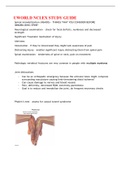
-
UWORLD NCLEX STUDY GUIDE
- Summary • 84 pages • 2022
-
- $9.99
- + learn more
UWORLD NCLEX STUDY GUIDE Spinal immobilization (NSAIDS) – THINGS THAT YOU CONSIDER BEFORE IMMOBILIZING SPINE* Neurological examination – check for focal deficits, numbness and decreased strength Significant Traumatic mechanism of injury Alertness Intoxication – if they’re intoxicated they might lack awareness of pain Distracting injury – another significant injury distracting them from spinal pain Spinal examination – tenderness of spine or neck, pain on movement Pathologic ve...

Study stress? For sellers on Stuvia, these are actually golden times. KA-CHING! Earn from your study resources too and start uploading now. Discover all about earning on Stuvia

